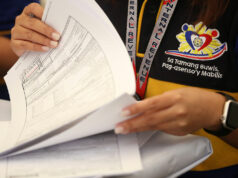Peso strengthens vs dollar on profit taking
THE PESO closed stronger against the US dollar on Wednesday, retreating to the P50 level, as market players took profits after the local currency’s steep decline on Tuesday.
The peso ended Wednesday’s session at P50.96 versus the greenback, gaining 14 centavos from the P51.10-per-dollar finish seen on Tuesday.
Yesterday’s session opened with the peso strengthening to P51.05 against the greenback. Its lowest point for the session was registered at P51.12, while it reached an intraday high of P50.92 versus the dollar.
Dollars traded slipped to $791.45 million from the $878.5 million that changed hands in the previous session.
“The peso [strengthened] due to profit taking after the steep price [on Tuesday],” a trader said over the phone.
On Tuesday, the local unit plunged by 26.5 centavos to close at P51.10-per-dollar.
Market players attributed the peso’s drop to the weaker-than-expected Philippine gross domestic product (GDP) growth data, as fourth-quarter growth stood at 6.6%. This was slower than the revised 7% growth a quarter ago, and slightly lower than the 6.7% projections by economists.
“Investors likely shrugged off yesterday’s unpleasant data and focused more on the country’s upbeat prospects this year,” Guian Angelo S. Dumalagan, market economist of Land Bank of the Philippines, said in an e-mail.
“While domestic growth slowed, it was still generally firm, supported by rising government spending.”
In its 2018 outlook, Standard Chartered Bank said the Philippine economy will remain stable for this year, forecasting a 6.7% GDP growth on the back of accelerated infrastructure investments.
The first trader added the peso’s uptick was also driven by the weakening of the US currency against major currencies.
For today, two traders expect the peso to move between P50.80 and P51.10, while Mr. Dumalagan gave a slightly slimmer range of P50.85 to P51.05.
Meanwhile, Standard Chartered Bank said the peso’s depreciation meant the local currency veers away from overvaluation.
“The good news is that the peso is not overvalued anymore. In fact, in our estimates, the peso is very close to its fair value,” Divya Devesh, foreign exchange strategist of Standard Chartered, said in a press briefing.
Mr. Devesh added the peso turned negative since November 2015 due to overvaluation.
However, headwinds for the local currency will still prevail this year amid the current account deficit and onshore dollar demands.
Standard Chartered reported the country’s current account is likely to remain under pressure in the first half of the year on a “still-wide trade deficit and slower remittance growth.”
In November, the country registered a trade deficit of $3.78 billion, wider than the $2.49 billion shortfall in a comparable year-ago period.
Mr. Devesh added the on-the-ground sentiment for the peso continues to be weak.
“Domestic demand for dollar is still quite strong, and we see that in terms of higher demands for foreign currency debt or foreign currency deposits,” he said. — Karl Angelo N. Vidal



